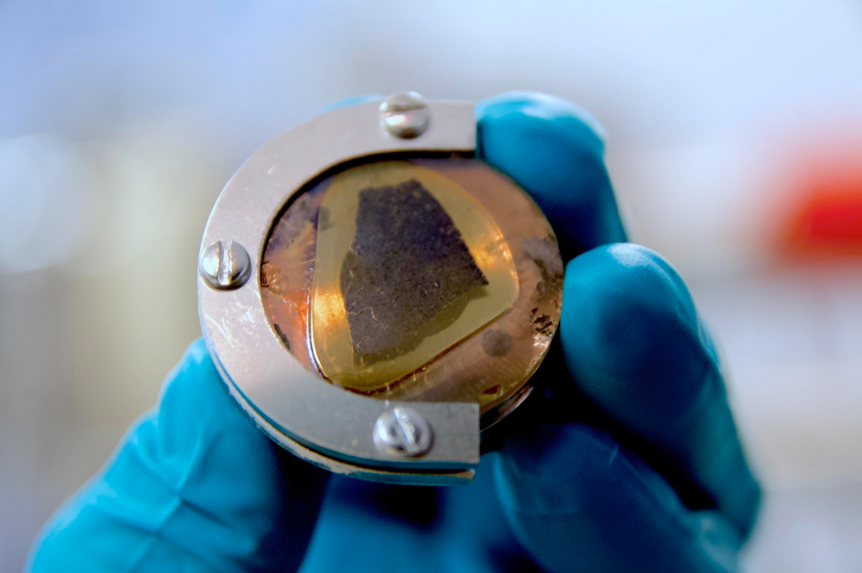Create a free profile to get unlimited access to exclusive videos, sweepstakes, and more!
This meteorite is so old, it saw the solar system light up before the Sun was born

UV light is the main reason we have to wear sunscreen, but where did all the ultraviolet rays in our solar system come from?
Billions of years ago, a meteorite floating around in the early solar system silently watched as UV radiation bombarded nascent planets. There had been debates over whether such immense amounts of UV light had come from ancient stars that existed before the Sun, or from the young Sun itself. Through the isotopes found in it, a meteorite from the early solar system has now revealed that the light was probably from a massive long-dead star that left its impression on those rocky planets.
The Genesis mission had previously found that oxygen isotopes on Earth, the Moon and other relatively nearby objects were different than those from the Sun. Now the meteorite Acfer 094 has proven that the irradiation of the solar system in the beginning was caused by stars other than the one we orbit. Astrophysicist Lionel Vacher of Washington University in St. Louis found out how starlight shaped the stardust we are made of. He led a study recently published in Geochimica et Cosmochimica Acta.
“Acfer 094 is a very interesting and unique meteorite,” Vacher told SYFY WIRE in an interview. “It is one of the most primitive meteorites that we have in our collection because its mineralogy and chemical composition tell us that this meteorite has not been modified significantly after its accretion by secondary asteroidal processes.”
This piece of space rock (below) is a time capsule in which isotopes from the cloud of gas and dust that it and the rest of the solar system originated in are still preserved. Most meteorites that fall to Earth have gone through processes such as hydrothermal alteration and heating from impacts (things really took a beating as the solar system formed) or radioactive substances. Acfer 094 is almost pristine in comparison. How it escaped the ravages of space is unknown, but it possibly formed far out, beyond Jupiter, from hydrogen sulfide ice, organics and presolar materials.
Enter cosmic symplectite. There is no other known meteorite that contains this mashup of iron oxide, iron sulfide and some of the heaviest oxygen isotopes. This is what gave away that the dawn of UV light in the solar system did not come from the Sun, because our star has 6% more of the lightest oxygen isotope than everything orbiting it. This is because primordial UV light bombarded objects in what would become the solar system and broke apart the carbon monoxide in them into its atomic components. Cosmic symplectite was the by-product.
“The isotopic anomalies recorded in cosmic symplectite likely indicate that our Solar System was formed near massive stars that irradiated the parent solar molecular cloud,” Vacher said. “Fortunately for us, the Sun didn't form too close to these giant stars, otherwise we wouldn’t be here to talk about it.”
So what were the monster stars that lit up the solar system with so much UV light? Smaller, Sun-like stars commonly form close to astral monsters such as massive O and B-type stars. These highly energetic stars live fast and die hard. Their UV spectra are also vastly different from stars like our Sun, and their UV light breaks apart gaseous hydrogen sulfide, which leaves behind heavy sulfur isotopes. Either, or both, types of stars were probably in the same stellar cluster from which the sun emerged.
When their powerful radiation of O or B stars (or both) split apart gases such as hydrogen sulfide, they created isotopes that shape the developing environment in the hazy cloud where the Sun was forming. The difference in spectra between the Sun and the stars that predated it allowed Vacher and his team to compare the sulfur isotopes in the cosmic symplectite with previous predictions. Even a small piece of Acfer 094 was enough to perform isotopic analyses on, which allowed it to whisper the secrets of the extremely early solar system to Vacher and his team.
“We were able to compare the sulfur isotopic anomalies of the cosmic symplectite with these theoretical models and tell that the sulfur isotopic anomalies recorded in cosmic symplectite are consistent with irradiation from massive star(s), not from the young Sun,” he said.
So remember, we aren’t just made of stardust; in a way, we were also made by starlight.



























